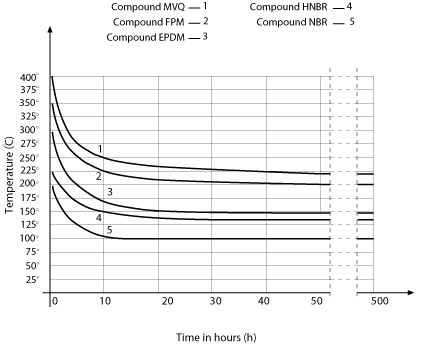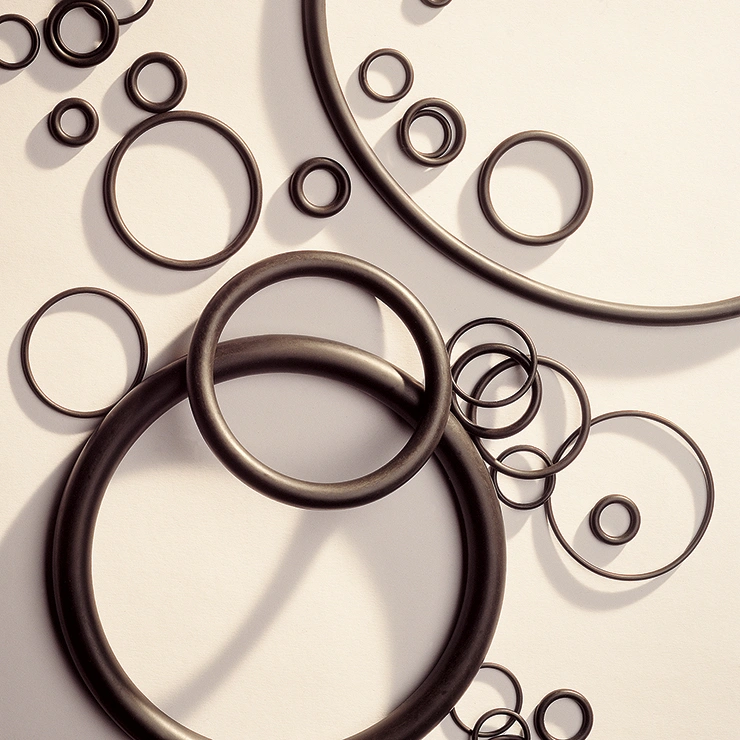Exercise in extreme conditions
Closing this brief chapter that has demonstrated some of the applications in which the O-Rings find vast uses with optimum results, we would like to speak about the problems which you come across when the pressure and temperature values move away in a decisive way from those comparable in the normal applications. In this paragraph we define how "extreme" those working atmospheres in which increased pressure and temperature values very high or very low, induce strong modification of the elastic behaviour of the compounds amounting to the O-Ring. When the fluid exercises very high pressures on to the system organs, the O-Ring is compressed against the seal walls in proximity of the diametric play existent between the elements, and the fluid penetrates in the compound forming pockets underneath the surface of the ring. In the dynamic seal applications, the increased pressure and the formation of these fluid deposits could represent a serious problem for the seal, so much so that the pressure, compromising the O-Ring against the walls seriously increases the friction between them, and the pockets form uneven areas that could be origin of lacerations due to the abrasion. These lacerations can bring in a short time the destruction of the ring. The danger of extrusion that manifests itself in the dynamic applications, also re-proposes itself in the static seal applications when the pressure reaches extremely high values in relation to the strength of the compound that forms the O-Ring; for these cases, the use of anti-extrusion rings is recommended. If at high pressures it arrives at a raised exercise temperature, the problems shown previously are increased, so much so the high temperatures provoke the compound to soften, easing the extrusion of the O-Ring and increasing the fluid aggressiveness in circulation. The most used compounds in the high pressure and temperature applications are those with an FPM or EPDM base.
The increased temperature is a one factor that can lead to the destruction of the O-Ring also without the effects linked to high pressure. Actually, high temperature values accelerate the ageing processes to the compound, reducing the time that the O-Ring is able to supply adequate performance considerably. In figure 7.1, it graphically shows the result of various tests which we have carried out to evaluate the deterioration of the seal performance of different compounds used in work cycles at different temperatures.
Amongst the applications that subject the O-Rings to extreme conditions of solicitation, we find also those at a very low temperature. In these usage conditions, the O-Rings lose their elasticity and become fragile. This loss of property is reversible to the extent that by following this with a heating process, the O-Rings return to their original finishing characteristic and mechanics. The fragility that comes as a result of the low temperatures eases the breaking of the O-Rings due to greases that can occur in dynamic applications, or necessary sudden counter hits of variations in internal circuit pressure. Of the recommended compounds for the use in these exercise conditions, those with a silicon base demonstrated to maintain a sufficient seal capacity at low temperatures, but displayed a limited resistance to the abrasion and the grease, factors which are not recommended in the use of dynamic applications.
The increased temperature is a one factor that can lead to the destruction of the O-Ring also without the effects linked to high pressure. Actually, high temperature values accelerate the ageing processes to the compound, reducing the time that the O-Ring is able to supply adequate performance considerably. In figure 7.1, it graphically shows the result of various tests which we have carried out to evaluate the deterioration of the seal performance of different compounds used in work cycles at different temperatures.
Amongst the applications that subject the O-Rings to extreme conditions of solicitation, we find also those at a very low temperature. In these usage conditions, the O-Rings lose their elasticity and become fragile. This loss of property is reversible to the extent that by following this with a heating process, the O-Rings return to their original finishing characteristic and mechanics. The fragility that comes as a result of the low temperatures eases the breaking of the O-Rings due to greases that can occur in dynamic applications, or necessary sudden counter hits of variations in internal circuit pressure. Of the recommended compounds for the use in these exercise conditions, those with a silicon base demonstrated to maintain a sufficient seal capacity at low temperatures, but displayed a limited resistance to the abrasion and the grease, factors which are not recommended in the use of dynamic applications.
 Figure 7.1
Figure 7.1
High pressure or extreme temperature conditions require, as we have seen, particular attention in the choice of O-Ring compound; our technical department are available to assist you in singling out the best product for your requirements.
